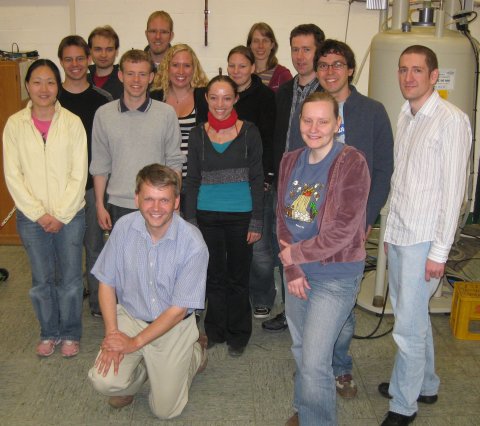Report of the 9. DMG Shortcourse "Applications of Solid State NMR Spectroscopy in the mineralogical and geoscientific research "
in Bochum from 02. - 05. June 2009

“Du bist keine Schönheit – vor Arbeit ganz grau” („I know you're no beauty, for work's lined your face “, H. Grönemeyer, song “Bochum) – that was the first impression, when we arrived in Bochum on Tuesday afternoon (2nd of June) and that impression was strongly influenced by an apparently never-ending drive of ten hours with a complete standstill of about 6 hours on the highway A2. The next thing to get over was the oversupply of parking opportunities in the university’s multi-storey car park (hard to handle for people coming from Berlin and Potsdam). But finally we could get started: “Applications of solid NMR-spectroscopy in geosciences and mineralogical research”.
The course was arranged by the DMG (German Mineralogical Society) and the DGK (German Society for crystallography), that both granted financial support for their student members. The group consisted of undergraduate students, graduates and post-docs from all over Germany. The head of the course, PD Dr. Michael Fechtelkord of the institute of geology, mineralogy and geophysics of the Ruhr-Universität Bochum, started on giving a general introduction in NMR spectroscopy. He explained the method in its basics and pointed out its relevance for structure determination and the assessment of dynamic processes in solids. To perform NMR spectroscopy a magnetic moment not equal to zero (I > 0) of the atom nuclei, as for 1H, 2H and 29Si, is required. The advantage over other structure determination methods (e.g. diffraction methods) is the possibility to examine the short-range order especially from amorphous solids. By discussions with other participants it once more became apparent that the combination of both methods is the key to structure determination.
The workshop was organized into a theoretic part in the morning and in a practical one in the afternoon. The first day started with an instruction to the spectrometer. We learned the rules of conduct close to the machine as well as details of the sample preparation. Afterwards we conducted temperature-dependent experiments on tetramethylammonium iodide in order to determine the activation energies and the correlation times of the different processes (spin-lattice relaxation).
Wednesday’s topic was the chemical shift and magnetic dipolar interactions between homo- and heteronuclear atoms. Furthermore the Magic Angle Spinning method was explained theoretically and practically by means of the mineral phlogopite. The analyses of the spectra were conducted by the program WinFit.
On Thursday, different multi-pulse methods were introduced (cross-polarization method (CPMAS), INADEQUATE). In the practical part we determined inter-atomic distances (H-Si).
The last workshop day dealt with electric quadrupolar interactions and different methods related to that subject: double rotation (DOR), Multi Quantum Magic Angle Spinning (MQMAS), and Satellite Transition Spectroscopy (SATRAS). The practical part covered analysis of 23Na MAS und 27Al SATRAS spectra.
To sum it up, the short course was very informative and interesting for all participants. Especially the practical application of the theory gave a clear insight into the varied possibilities for application of NMR-spectroscopy. In this regard the composition of the group of people from different geo- and materials scientific backgrounds helped, to understand and make clear how the method can be used in various ways. The social evenings were very cozy and we enjoyed the pleasant atmosphere during the whole workshop.
We would like to take this opportunity to thank Michael Fechtelkord and his PhD student Ramona Langner for the organization of these evenings and the workshop as a whole.
Maria Mrosko and Fiorenza Deon,
Potsdam


